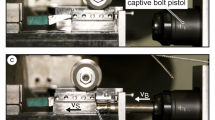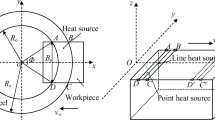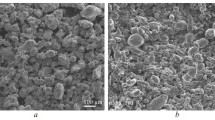Abstract
Mixed oxide ceramics show high potential for widespread utilization due to the transformation toughening effect of these ceramics. During grinding, the stress-induced transformation from the tetragonal to the monoclinic phase of ZrO2 particles ensures a high strength in combination with a high fracture toughness even after processing with unavoidable surface and subsurface damage due to micro-cracks. The thermal impact during grinding can be one of the main limitations of this transformation toughening effect in case of exceeding the temperature of retransformation back to the tetragonal phase. Thus, the technological basis for a reliable grinding process of mixed oxide ceramics requires a fundamental understanding of the grinding temperatures to maintain workpiece quality and strength requirements. This paper presents an analytical method to calculate the maximum grinding temperatures beneath a single abrasive grain and show their effect on the bending strength of ground mixed oxide ceramics as well as on the monoclinic phase content and on the residual stresses.












Similar content being viewed by others
References
Garvie RC, Hannink RH, Pascoe RT (1975) Ceramic steel? Nature 258:703–704
Chevalier J, Gremillard L, Virkar AV, Clarke DR (2009) The tetragonal-monoclinic transformation in Zirconia: lessons learned and future trends. J Am Ceram Soc 92(9):1901–1920
Claussen N (1982) Umwandlungsverstärkte keramische Werkstoffe. Z Werkstofftech 13:138–147
Tönshoff HK, Denkena B (2013) Basics of cutting and abrasive processes. Lecture Notes in Production Engineering, Springer
Rowe WB, Black SCE, Mills B, Qi HS (1996) Analysis of grinding temperatures by energy partitioning. Proc Instn Mech Engrs 210:579–588
Guo C, Wu Y, Varghese V, Malkin S (1999) Temperatures and energy partition for grinding with vitrified CBN wheels. Ann CIRP 48:247–250
Zhu B, Guo C, Sunderland JE, Malkin S (1995) Energy partition to the workpiece for grinding of ceramics. Ann CIRP 44:267–271
Malkin S, Guo C (2007) Thermal analysis of grinding. Ann CIRP 56:760–782
Kohli S, Guo C, Malkin S (1995) Energy partition to the workpiece for grinding with aluminum oxide and CBN abrasive wheels. Trans ASME 117:160–168
Hessert R, Eigenmann B, Vöhringer O, Löhe D (1997) Fracture mechanical evaluation of the effects of grinding residual stresses on bending strength of ceramics. Mater Sci Eng A 234-236:1126–1129
Jaeger JC (1942) Moving sources of heat and the temperature at sliding contacts. J Proc Soc NSW 76:202–224
Surberg CH, Wuthnow H (1996) Rötgenographische analyse der ZrO2-polymorphen an Pulvern. Cfi/Ber DKG 73(11/12):674–677
Jahanmir S, Ramulu M, Philip K (1999) Machining of ceramics and composites. Marcel Dekker
Lierse T (1998) Mechanische und thermische Wirkungen beim Schleifen keramischer Werkstoffe. Dr.-Ing. Dissertation, Hannover
Ramanath S, Shaw MC (1988) Abrasive grain temperature at the beginning of the cut in fine grinding. J Eng Ind 110:15–18
Klocke F, König W (2005) Fertigungsverfahren 2, Schleifen, Honen, Läppen. Springer
Battaglia JL (2008) Heat transfer in materials forming processes. Wiley
Denkena B, Gottwik L, Grove T, Wippermann A (in press) Material removal mechanisms in grinding of mixed oxide ceramics. Procedia CIRP, 3rd BioManufacturing Conference (CIRP BioM)
Claussen N (1977) Stress-induced transformation of tetragonal ZrO2 particles in ceramic matrices. J Am Ceram Soc 61:85–86
Claussen N (1982) Umwandlungsverstärkte keramische Werkstoffe. Z. Werkstofftech. 13:185–196
Acknowledgements
The authors would like to thank the German Research Foundation (DFG) for its support of the subproject T5 within the Collaborative Research Center 599 “Sustainable bioresorbable and permanent implants of metallic and ceramic materials”.
Author information
Authors and Affiliations
Corresponding author
Rights and permissions
About this article
Cite this article
Denkena, B., Gottwik, L., Grove, T. et al. Temperature and energy partition for grinding of mixed oxide ceramics. Prod. Eng. Res. Devel. 11, 409–417 (2017). https://doi.org/10.1007/s11740-017-0757-0
Received:
Accepted:
Published:
Issue Date:
DOI: https://doi.org/10.1007/s11740-017-0757-0




